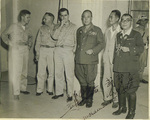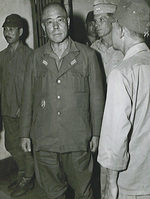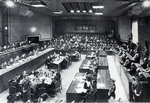Tokyo Trial and Other Trials Against Japan
Contributor: C. Peter Chen
ww2dbaseThe International Military Tribunal for the Far East (IMTFE), also known as the Tokyo Trial or the Tokyo War Crimes Tribunal, tried Japanese leaders accused for war crimes and other charges committed between 1937 and 1945. The legal basis for the trial was established by the Charter of the International Military Tribunal for the Far East (CIMTFE), which was proclaimed on 19 Jan 1946 by Supreme Commander of the Allied Powers General Douglas MacArthur. The Tokyo Trial began on 3 May 1946 at Ichigaya Court (formerly the Japanese Army headquarters building) in Tokyo, Japan. The members of the tribunal were:
ww2dbasePresident of the International Military Tribunal
Sir William Webb (Australia)
ww2dbaseJudges
Edward Stuart McDougall (Canada)
Major General Mei Ju-ao (China)
Henri Bernard (France)
Radhabinod Pal (India)
Professor Bert Röling (Netherlands)
Harvey Northcroft (New Zealand)
Colonel Delfin Jaranilla (Philippines)
Honorable Lord Patrick (United Kingdom)
John P. Higgins (United States; through Jul 1946)
Major General Myron C. Cramer (United States; after Jul 1946)
Major General I. M. Zarayanov (Soviet Union)
ww2dbaseChief Prosecutor
Joseph Keenan (United States)
ww2dbaseProsecutors
Mr. Justice Alan Mansfield (Australia)
Brigadier Henry Nolan (Canada)
Xiang Zhejun (China)
Robert L. Oneto (France)
P. Govinda Menon (India)
W. G. Frederick Borgerhoff-Mulder (Netherlands)
Brigadier Ronald Henry Quilliam (New Zealand)
Pedro Lopez (Philippines)
Arthur Strettell Comyns Carr (United Kingdom)
Judge Sergei Alexandrovich Golunsky (Soviet Union)
ww2dbase28 Japanese leaders were charged with Class A crimes, and more than 5,700 were charged with Classes B and C crimes. Class A included those who were charged with crimes against peace, Class B was a category for those accused of war crimes, and those charged with crimes against humanity were said to be in Class C. Members of the Japanese imperial family, including Emperor Showa (Hirohito), were granted immunity by MacArthur.
ww2dbaseTwo of the accused Class A criminals, Matsuoka Yosuke and Nagano Osami, died of natural causes during the trial. Seven were found guilty and sentenced to death, with the executions carried out at Sugamo Prison, Tokyo, Japan on 23 Dec 1948. Those executed were:
Baron Koki Hirota
General Seishiro Itagaki
General Heitaro Kimura
General Iwane Matsui
General Akira Muto
General Hideki Tojo
ww2dbase16 of them were sentenced to life imprisonment:
Colonel Kingoro Hashimoto
Field Marshal Shunroku Hata
Baron Kiichiro Hiranuma
Naoki Hoshino
Okinori Kaya
Marquis Koichi Kido
General Kuniaki Koiso
General Jiro Minami
Admiral Takasumi Oka
General Hiroshi Oshima
General Kenryo Sato
Admiral Shigetaro Shimada
Toshio Shiratori
General Teiichi Suzuki
General Yoshijiro Umezu
ww2dbaseFinally, Shigenori Togo received 20 years imprisonment and Mamoru Shigemitsu received 7 years imprisonment.
ww2dbaseOf the 5,700 accused of Class B and Class C crimes, 984 were condemned to death (some were later pardoned), 475 were given life imprisonment sentences, 2,944 were given finite imprisonment sentences, 1,018 were acquitted, and 279 were not brought to trial or not sentenced.
ww2dbaseThere were criticisms of the Tokyo Trial, which mostly centered around the American bias through the entire proceedings as well as the immunity enjoyed by members of the imperial family. Judge Radhabinod Pal of India offered a dissenting opinion, questioning the exclusion of western imperialism and the American use of the atomic weapons from the trial while Japanese imperialism and Japanese use of chemical and biological weapons were central to the Tokyo Trial.
ww2dbaseOther Trials
ww2dbaseBetween 1945 and 1951, over 2,200 trials were held outside of Japan against 5,600 Japanese nationals and Japanese collaborators accused of various crimes. More than 4,400 were convicted, and about 1,000 were sentenced to death.
ww2dbaseBetween 29 Oct and 7 Dec 1945, an American military tribunal tried General Tomoyuki Yamashita in Manila, Philippines for war crimes. The trial was publicized greatly in the Philippines; Yamashita symbolized the Japanese officers that the Filipinos came to blame for the war time atrocities, and the press build up swayed the public opinion against the Japanese general. He was found guilty and was executed by hanging on 23 Feb 1946 at Los Banos Prison Camp 30 miles south of Manila. His responsibilities for the atrocities as the commanding officer later came to be known as the Yamashita Standard, which set precedence for future war crimes rulings.
ww2dbaseThe Khabarovsk War Crime Trials between 25 and 29 Dec 1949 at Khabarovsk in Russian Far East, conducted by the Russians, tried 12 members of the Japanese Kwangtung Army for the use of biological weapons. All 12 were found guilty and were sentenced to various imprisonment terms.
Lieutenant General Ryuji Kajitsuka
Lieutenant General Takaatsu Takahashi
Major General Kiyoshi Kawashima
Major Tomio Karasawa
Lieutenant Colonel Toshihide Nishi
Major Masao Onoue
Major General Shunji Sato
Lieutenant Zensaku Hirazakura
Senior Sergeant Kazuo Mitomo
Corporal Norimitsu Kikuchi
Yuji Kurushima
ww2dbaseIn 1946, the Chinese government held a series of trials against Japanese Army officers for crimes committed in occupied China. In the Nanjing Trials, one of a total of thirteen trials held by Nationalist China (the communists held their own trials against the Japanese), the following four Japanese officers were found guilty and sentenced to death in 1947.
Captain Gunkichi Tanaka
Second Lieutenant Toshiaki Mukai
Second Lieutenant Tsuyoshi Noda
ww2dbaseSource: Wikipedia.
Last Major Update: Jan 2009
Tokyo Trial and Other Trials Against Japan Interactive Map
Photographs
 |  |  |  |
Tokyo Trial and Other Trials Against Japan Timeline
| 11 Sep 1945 | The Allied occupation administration in Tokyo, Japan announced 39 war criminals and ordered their arrests. |
| 25 Sep 1945 | The Philippine People's Court was established by President Sergio Osmeña to try war time collaborators. |
| 3 Oct 1945 | The case "People of the Philippines vs. Teofilo Sison" was filed in Manila, Philippines as the first case against war time collaboration leaders. |
| 8 Oct 1945 | Japanese General Tomoyuki Yamashita was arraigned in war crimes court in the Philippine Islands. |
| 29 Oct 1945 | Trial against Japanese General Tomoyuki Yamashita began in Manila, Philippine Islands. |
| 19 Jan 1946 | General Douglas MacArthur established the International Military Tribunal for the Far East in Tokyo, Japan to try Japanese war criminals. |
| 5 Feb 1946 | US Army attorney Colonel Harry Clarke wrote to US Secretary of War Robert Patterson in request of clemency for General Tomoyuki Yamashita. |
| 25 Apr 1946 | In Hong Kong, a war crimes court presided by Lieutenant-Colonel J. C. Stewart found Lieutenant Yasuo Kishi, Lieutenant Chozaburo Matsumoto, and Sergeant Major Hiroshi Uchida guilty of war crimes committed against civilians at Mui Wo, Lantau Island, Hong Kong between 19 Aug and 27 Aug 1945; they were sentenced to death by hanging. 10 others were also found guilty and given prison terms ranging from 2 years to 10 years. 3 of the defendants were acquitted. |
| 29 Apr 1946 | 28 former Japanese leaders were indicted as war criminals at Tokyo, Japan. |
| 27 Aug 1946 | In Nanjing, China, Takashi Sakai was found guilty of war crimes, by command responsibility, for the rape and extrajudicial killing of civilians and prisoners of war committed by his subordinates. |
| 30 Sep 1946 | Takashi Sakai was executed by firing squad on Yuhuatai Mountain in the southern side of Nanjing, China. |
| 6 Feb 1947 | A court in Najing, China, Lieutenant General Hisao Tani, commanding officer of the Japanese 6th Division in Nanjing from late 1937, was found guilty of encouraging his men to commit crimes such as rape, murder, plunder, and destruction. |
| 10 Mar 1947 | Lieutenant General Hisao Tani was sentenced to death by a court in Nanjing, China for encouraging his men to commit crimes such as rape, murder, plunder, and destruction at Nanjing in 1937 and 1938. |
| 17 Jun 1947 | War criminals Sergeant Jiro Shimoda and Captain Harochi Yonemura were executed in Shanghai, China. Shimoda had plundered and raped Chinese civilians during the occupation, including several murders committed at Jianying 85 miles northwest of Shanghai on the date of the surrender. Yonemura had ordered enlisted men under his command to bury, while alive, more than 100 Chinese civilians in Changshu near the city of Suzhou. |
| 11 Mar 1948 | 30 Japanese officers, doctors, and a female nurse were tried by the Allied war crimes tribunal for human experimentation in China. 23 of them would later be found guilty, with 5 sentenced to death. |
| 12 Nov 1948 | Tokyo war crimes trials ended with eight war criminals sentenced to death and seventeen others to periods of imprisonment. |
| 23 Dec 1948 | Seven Japanese convicted of war crimes by the International Military Tribunal for the Far East were executed at Sugamo Prison in Tokyo, Japan. |
| 25 Dec 1949 | Khabarovsk War Crime Trials against 12 members of the Japanese Kwantung Army began. |
| 29 Dec 1949 | Khabarovsk War Crime Trials concluded with all 12 accused members of the Japanese Kwantung Army found guilty and given prison sentences. |
| 7 Mar 1950 | Douglas MacArthur issued an order that reduced the sentences of convicted Japanese war criminals by a third for good behavior and to allowed the possibility of parole after 15 years for those who received life sentences. |
| 11 May 1950 | The final execution of Japanese war criminals condemned by the Saigon Permanent Military Tribunal took place. |
| 4 Sep 1952 | US President Harry Truman issued Executive Order 10393 which established the Clemency and Parole Board for War Criminals. |
| 26 May 1953 | President Ho Chi Minh of Vietnam pardoned Japanese Class B and Class C criminals who were condemned by the French-run Saigon Permanent Military Tribunal between 1945 and 1950. |
| 26 May 1954 | US Secretary of State John Foster Dulles rejected a proposed amnesty for the imprisoned war criminals, but agreed to reduce the eligibility for parole from 15 years imprisonment to 10 years. |
| 7 Apr 1957 | The Allied powers and Japan jointly agreed to grant clemency to already-paroled Japanese war criminals. |
Please consider supporting us on Patreon. Even $1 per month will go a long way! Thank you. Please help us spread the word: Stay updated with WW2DB: |
Visitor Submitted Comments
10 Feb 2011 01:21:20 PM
Japanies Emperor should have stood trial for the actions he let happen during the war.
26 Feb 2012 01:21:51 AM
Difficult to understand, why? some have to hate their fellow men! we are all like tiny, which together make up an image on a huge screen, which represents the global image of the world. All are important where we are, and participate in evolution all through our work in our portion.
19 Sep 2012 03:03:07 AM
And when is the trial for the U.S war crimes in Iraq,Afghanistan,Yemen,Vietnam just to name a few? When will Chinese be on trial for genocide in Tibet, Uyghur, Taiwan, and Falun Gong practitioners?When is Israel going to trial for genocide in palestine?
5 Aug 2017 11:44:03 PM
Why is US not brought to trial for war crimes in Hiroshima and Nagasaki? If that's not a crime then Pearl Harbor is walk in the park. India will always stand by Japan.
17 Nov 2017 02:03:28 PM
was the term "world war II" or "the second world war" used in any documents of IMTFE?
3 Feb 2018 03:36:07 PM
Definitely a "stacked" trial. several of the western witnesses (Bates, Fitch) were advisors to Chiang Kai shek. Fitch also was a KMT government agent.
25 Jul 2024 07:55:31 AM
Honestamente, foi pouco, deveriam ter executado pra vale com direito a muro de fuzilamento aqueles malditos da unidade 731 e suas variantes, todos deveriam responder por aquilo!
O inferno é pouco para eles, malditos bastardos!
All visitor submitted comments are opinions of those making the submissions and do not reflect views of WW2DB.

» Morimasa
» Puyi
» Doihara, Kenji
» Hara, Chuichi
» Hata, Shunroku
» Hirota, Koki
» Hong, Sa-ik
» Koiso, Kuniaki
» Matsui, Iwane
» Matsuoka, Yosuke
» Minami, Jiro
» Muto, Akira
» Nagano, Osami
» Oshima, Hiroshi
» Sakai, Takashi
» Sato, Shunji
» Sejima, Ryuzo
» Shiratori, Toshio
» Tani, Hisao
» Tojo, Hideki
» Yamada, Otozo
» Yamashita, Tomoyuki
Location:
» Japan
 |
- » 1,176 biographies
- » 337 events
- » 44,933 timeline entries
- » 1,245 ships
- » 350 aircraft models
- » 207 vehicle models
- » 376 weapon models
- » 123 historical documents
- » 261 facilities
- » 470 book reviews
- » 28,471 photos
- » 365 maps
Lt. Gen. Lewis B. "Chesty" Puller, at Guadalcanal
Please consider supporting us on Patreon. Even $1 a month will go a long way. Thank you!
Or, please support us by purchasing some WW2DB merchandise at TeeSpring, Thank you!
29 Oct 2010 02:18:15 AM
great site, thanks,
but how do I buy a copy of Pal's judgement, published in Calcutta by Sanyal press in 1953?
can anyone help pls?